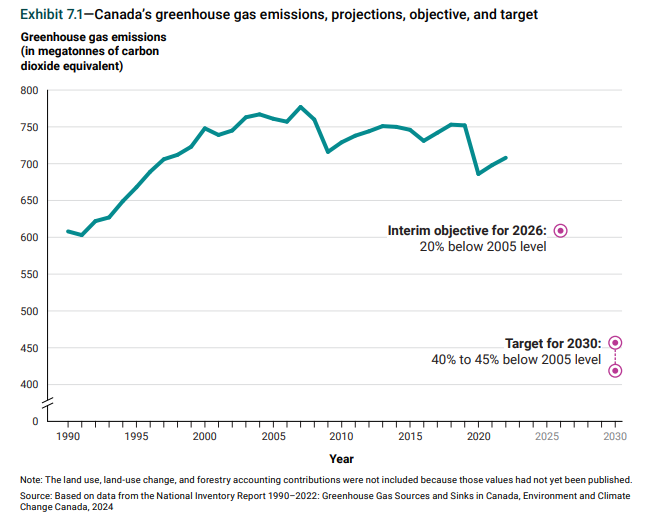Contributed by Robert Lyman © 2025. Robert Lyman’s bio can be read here.

EXECUTIVE SUMMARY
The Carney government and almost all provincial governments are committed to attain “Net-Zero” by 2050. So, what does the future hold?
In two recent reports, the federal government has described the progress that has been made in attaining the target of reducing Canada’s annual greenhouse gas (GHG) emissions by 2030 and setting new targets for 2035. As usual, there has been remarkably little media coverage or analysis of these reports. The first was Canada’s First Biennial Transparency Report under the Paris Agreement and the second was Canada’s 2035 Nationally Determined Contribution (NDC). This article will summarize the main elements of these reports and offer comments on them.
It is interesting to note that the political messaging that introduces both recent reports does not dwell on the alleged risks of calamity from climate change in 2100. Instead, the Minister of Environment and Climate Change (ECCC), in his opening message, focused entirely on claims that Canada is experiencing extreme weather events, the avoidance of which requires major reductions in Canada’s use of fossil fuels.

The base year for measuring emissions reductions is 2005, when according to ECCC, emissions totalled 761 million tonnes of carbon dioxide equivalent (Mt CO2 eq, or Mt for short).
In 2022, Canada’s total GHG emissions excluding those associated with land use were 708 Mt, or 7.1 % below 2005 levels. Including the land use accounting contribution, Canada’s emissions were 5.5% below 2005 levels. This is a long, long way from the 2030 target.
The target set in Canada’s first Nationally Determined Contribution sent to the United Nations was that emissions should decline by 40% to 45% from 2005 levels by 2030. Translating that into specific annual emissions levels, the goals are to reduce emissions to 609 Mt by 2026, and to between 419 Mt and 457 Mt by 2030. For context, over the period 2005 to 2022 emissions were reduced by 4.6 Mt. That is a reduction of 7.1%, or 0.4% per year on average. The government intends that from 2022 to 2030 emissions decline by at least 251 Mt, or an annual average of 31.4 Mt (12.6%).

At the end of 2024 the government announced Canada’s goals for the five-year period 2030 to 2035 Nationally Determined Contribution. The new target for 2035 is to reduce emissions by 45% to 50% below 2005 levels by 2035. So the new emissions goals are between 457 Mt and 370 Mt by 2035.
The Biennial Transparency Report sets out projections of future GHG emissions and removals, using the Energy, Emissions and Economy Model for Canada (E3MC). The model uses two scenarios, the “With Measures” (WM) scenario and the “With Additional Measures” (WAM) scenario. Under the WM scenario, total Canadian emissions decline to 597 Mt by 2030, 597 Mt by 2035 and 559 Mt by 2040. Under the WAM scenario, emissions decline to 502 Mt by 2030, 458 Mt by 2035 and 431 Mt by 2040. In other words, under all the existing and currently contemplated measures, the emissions reduction targets will be missed, unless additional measures are taken. No doubt there will be.
The reports include relatively little information about the measures that the federal government will take to bring these changes about, and no discussion of the costs. The implicit assumption appears to be that the technologies required to effect significant changes in the Canadian energy economy will be technologically proven and commercially viable and/or that government funding can be provided at extraordinary levels for at least the period to 2040, if not beyond.
It is long past time for Canadians to demand that climate policy, and the closely-related energy and fiscal policies that it now drives, be made more realistic and more attuned to the needs of the Canadian economy and the well-being of the Canadian people. At a minimum, that requires more transparency as to how the new targets will be met. Even better would be to abandon targets altogether.
Leave a Reply! Please be courteous and respectful; profanity will not be tolerated.